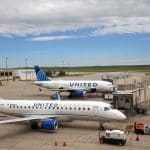TARMAC DELAY CONTINGENCY PLAN
RAPID CITY REGIONAL AIRPORT
Rapid City Regional Airport (RAP) has prepared this Tarmac Delay Contingency Plan pursuant to §42301 of the FAA Modernization and Reform Act of 2012. Questions regarding this plan can be directed to the Rapid City Regional Airport Executive Director, Patrick Dame, at patrick.dame@rcgov.org. Rapid City Regional Airport is filing this plan with the Department of Transportation because (1) it is a commercial airport or (2) this airport may be used by an air carrier described in USC 42301 (a)(1) for diversions.
This plan describes how, following excessive tarmac delays and to the extent practicable, Rapid City Regional Airport will:
• Provide for the deplanement of passengers;
• Provide for the sharing of facilities and make gates available at the airport; and
• Provide a sterile area following excessive tarmac delays for passengers who have not yet cleared United States Customs & Border Protection (CBP).
Rapid City Regional Airport has facility constraints that limit our ability to accommodate diverted flights and strongly encourages aircraft operators to contact Airport Operations at 605-593-3419 for prior coordination of diverted flights, except in the case of a declared in-flight emergency. Specific facility constraints include the following: lack of international passenger processing facilities, limited numbers of aircraft parking positions, inability to accommodate, park, or service certain types of aircraft and high seasonal gate demand in the summer months. Constraints have also been noted in Airport Facility Directory record for the Rapid City Regional Airport (RAP).
During diversion events Rapid City Regional Airport may issue NOTAMs regarding its ability to accommodate diverted flights to ensure the safe and efficient operation of the airport and its ability to serve the civil aviation needs of the public during irregular operations events.
AIRPORT INFORMATION
Name of Airport: Rapid City Regional Airport (RAP)
Original date of submission of plan: May 14th, 2012
Date of updated submission of plan: June 15th, 2022
CONTACT INFOMATION
In the event of diversion or other irregular operations events, aircraft operators should contact the Airport Operations Department at 605-593-3419 or rapops@rcgov.org for assistance.
PLAN TO PROVIDE FOR THE DEPLANEMENT OF PASSENGERS FOLLOWING EXCESSIVE TARMAC DELAYS
Rapid City Regional Airport has a limited amount of airport-owned equipment on hand to assist with the safe deplanement of passengers from air carrier aircraft and is, therefore, unable on its own, to provide for the deplanement of passengers. Additionally, airport personnel are not trained to assist in the deplanement of passengers using airport equipment or equipment owned or operated by air carriers or contract service providers. However, we will provide a list of airlines, ground handlers, fixed base operators and others who may have the necessary equipment and personnel to safely deplane passengers to airlines as soon as practicable after receiving requests from such airlines experiencing excessive tarmac delays at the contact number listed above.
PLAN TO PROVIDE FOR THE SHARING OF FACILITIES AND MAKE GATES AVAILABLE IN AN EMERGENCY
The gates at Rapid City Regional Airport are under common use gate leases, permits, or agreements to air carriers and are controlled by the airport. We direct our common use air carrier users to make gates and other facilities available to an air carrier seeking to deplane at a gate, to the maximum extent practicable.
PLAN TO PROVIDE A STERILE AREA FOR PASSENGERS WHO HAVE NOT CLEARED UNITED STATES CUSTOMS AND BORDER PROTECTION
Rapid City Regional Airport does not have international passenger processing facilities. We will coordinate with local CBP and law enforcement officials to identify suitable areas and procedures for establishing a temporary sterile area into which international passengers on diverted aircraft who have not yet cleared United States Customs and Border Protection can be deplaned. Once these efforts are complete, we will coordinate with local CBP officials to develop procedures that will allow international passengers who have not yet cleared United States Customs and Border Protection to be deplaned into these sterile areas to the extent practicable.





